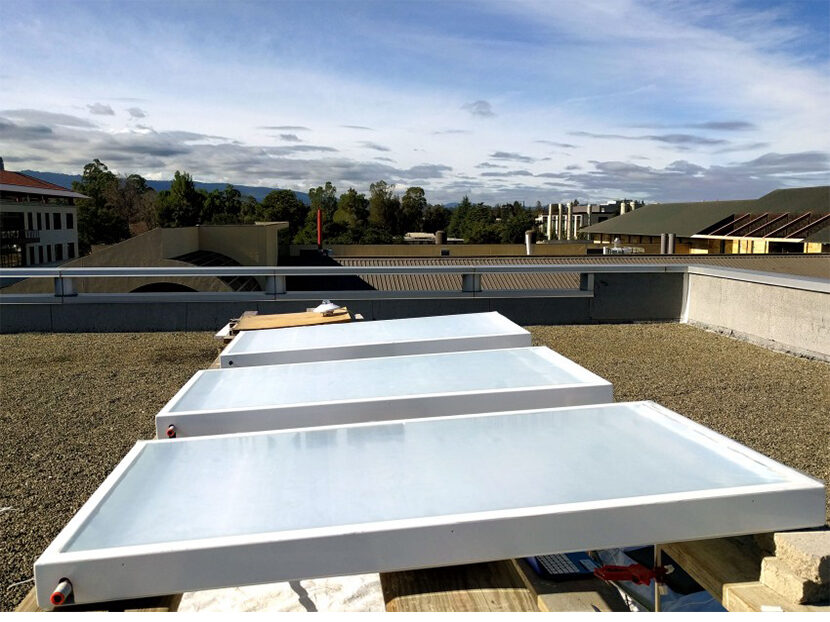Unconventional Approach to Cooling Sends Heat into Outer Space

Air-conditioning consumes 15 percent of all global electricity and generates 10 percent of global greenhouse gas emissions.
Three Stanford University researchers may have found a way to significantly cut down on both by using panels that harness “radiative sky cooling” to cool fluids below the air temperature with zero evaporative losses and almost no electricity.
As you may have already guessed, understanding how it works requires a bit of background. We’ll let the MIT Technology Review explain:
All objects give off heat in the form of infrared radiation, an invisible form of light just to the right of red on the spectrum. The point of jackets, mittens, and scarves is to retain as much of that radiant heat as possible, keeping us warm on winter days. The atmosphere itself, mainly in the form of water molecules, also radiates back a portion of the heat.
But a sliver of emissions in the mid-infrared range (with wavelengths between eight and 13 micrometers, for those keeping score) slips through, escaping through what has been described as a “window into space.” Materials emitting radiation in that range literally cast it into the cold expanses of space, or at least the cool upper atmosphere, allowing the surfaces themselves to dip below the temperature of the surrounding air. This natural phenomenon is what causes frost to form on surfaces under the open night sky, like car windows and blades of grass, even when into space.
A critical challenge for harnessing this mechanism in useful ways has been that during the day, the heat from the sun generally offsets any cooling effect. But in research first published in Nature in late 2014, the scientists behind SkyCool Systems got around that problem by developing an advanced material tuned to radiate infrared light in the range that slips through the atmosphere while also reflecting away 97 percent of sunlight. Placed on a roof under direct sunlight, the material remained 4.9 degrees C below ambient air temperatures, a “cooling power of 40.1 watts per square meter.”
Eli A. Goldstein, Aaswath P. Raman and Shanhui recently shared their research in paper published in Nature Energy.
The paper describes how the researchers tested their panels during warm, somewhat humid weather in Stanford, Calif. and used the data gathered to predict the efficiency of the panels operating under optimal conditions: the hot, dry climate of Las Vegas.
Their modeling predicts that a typical two-story office building in Las Vegas outfitted with the panels could reduce the amount of energy needed for cooling during the summer months by 21 percent.
The researchers say a scaled-up version of the technology can be used to cool flowing water. The water coolers are panels that sit atop a roof, and they’re made of three components:
- The first is a plastic layer topped with a silver coating that reflects nearly all incoming sunlight, keeping the panel from heating up in the summer sun.
- The plastic layer sits atop the second component, a snaking copper tube. Water is piped through the tube, where it sheds heat to the plastic. That heat is then radiated out by the plastic at a wavelength in the middle region of the infrared (IR) spectrum, which is not absorbed by the atmosphere and instead travels all the way to outer space.
- Finally, the whole panel is encased in a thermally insulating plastic housing that ensures nearly all the heat radiated away comes from the circulating water and not the surrounding air.
By setting up panels with thin water pipes running directly beneath them, the researchers lowered the temperature of water by 5 degrees C (or about 9 degrees F) over three days of testing.
The result suggests that the technology can be incorporated into existing cooling mechanisms by replacing or augmenting the condenser component used in conventional air-conditioning and refrigeration.
The ability to retrofit the system into existing buildings, lowering costs for owners and tenants, means the potential market is vast. About 14 percent of total U.S. energy production goes to cooling residential and commercial buildings
Three of the researchers involved in this work cofounded SkyCool Systems last spring in an effort to commercialize the technology: Goldstein is the startup’s chief technology officer; Raman serves as chief executive; and Fan, a Stanford professor of electrical engineering, acts as an advisor.




